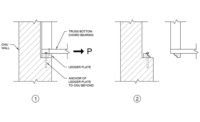For structural engineer Glenn Bell, the collapse on July 17, 1981, of a pedestrian bridge inside the Hyatt Regency Kansas City Hotel—which killed 114 people and injured more than 200—stands out as a defining event. The tragedy changed Bell’s career trajectory away from structural design and toward forensic engineering.
After the fiasco, Bell—six years out of school—became part of a team investigating the causes. The “gravity of it all and the responsibility of engineers for public safety really hit me,” says Bell, a retired senior principal of Simpson Gumpertz & Heger, where he spent his career, rising to CEO.
The Hyatt fiasco motivated Bell’s lifelong commitment to professional service, with the aim of improving practice. Bell’s latest campaign is a volunteer initiative, launched in July and designed to offer lessons about bridge- and building-related accidents, failures and near-failures.
Bell’s pet project—Confidential Reporting on Structural Safety-United States (CROSS-US)—is modeled after CROSS-UK, which started in 2005. CROSS-UK, in turn, was modeled after NASA’s Aviation Safety Reporting System.
It took until 2010 for CROSS-UK to really get rolling, says Bell. “People needed to be relatively free of concerns about confidentiality and backlash,” he adds. Bell is CROSS-US’s co-director, along with Andy Herrmann, partner emeritus of bridge engineer Hardesty & Hanover.
In 2010, CROSS-UK launched CROSS International, which has a free-to-use database for all confidential reports. Members are CROSS Southern Africa and CROSS-Australasia, in addition to CROSS-US. A German CROSS may soon join the pack.
Since 2005, CROSS has received more than 900 reports, which it strips of identifying factors. “We look for precursors to publicize and improve safety of all stages of the process—design, construction and in-service life,” says Alastair Soane, director of Structural-Safety, home to CROSS.
Thanks to Bell, CROSS-US is sponsored by the Structural Engineering Institute of the American Society of Civil Engineers. “Glenn was instrumental and fantastic about getting everyone on board,” says Herrmann. He adds that CROSS-US also will include reviews of public reports on high-profile failures, such as the Florida International University bridge collapse.
Persuading ASCE/SEI to sponsor CROSS-US took skill and patience, says Soane. Though discussions began at ASCE/SEI in 2011, nothing much happened until Bell took up the charge in 2016. “His abilities, knowledge, contacts and, above all, enthusiasm, are immense,” Soane adds.
“With time, there will be a cultural impact, as the concept of no-blame reporting becomes accepted and indeed becomes a norm in structural and civil engineering in the U.S.,” he says. Soane expects CROSS-US to trigger interest in other regions.
To date, CROSS-US has processed 12 reports, which include reviews by a panel of volunteers, research into relevant standards of practice, outreach to specialty experts, legal reviews and more. The first newsletter, containing five reports, is expected out in February, says Bell, who calls CROSS-US a “dream come true.”





Post a comment to this article
Report Abusive Comment